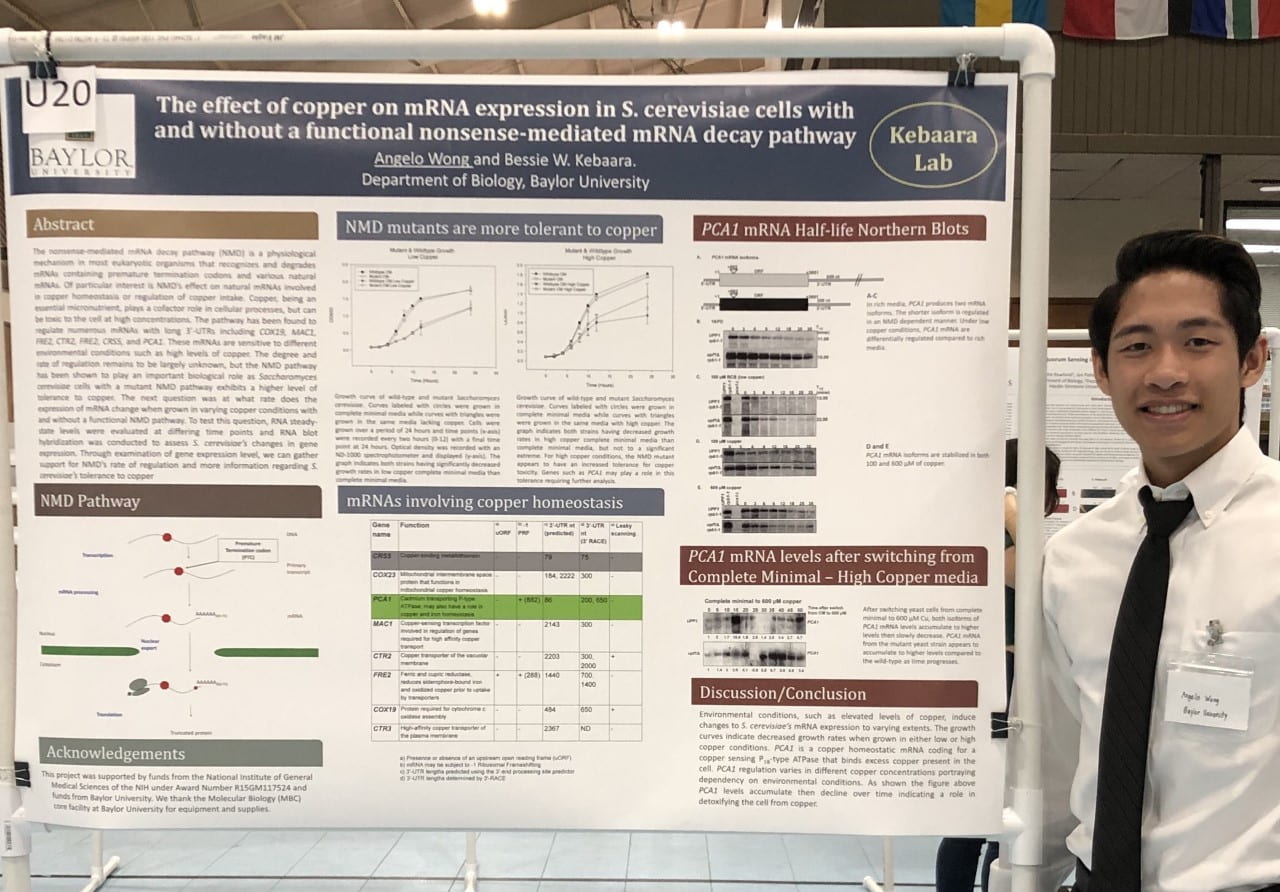Lab Team

Xinyi Zhang
Doctoral Candidate in Biology, Baylor University
Education:
B.S, Sichuan University, Chengdu, China
Courses Taught:
BIO 1105 Modern Concepts of Bioscience Laboratory
BIO 1102 Introduction to Microbiology
BIO 4102 General Microbiology Lab
Research Interests
Nonsense-mediated mRNA decay (NMD) pathway is a highly conserved degradation pathway that was primarily discovered to degrade mRNAs with premature termination codons (PTC). NMD is now also recognized as a pathway that regulates gene expression by regulating select natural mRNAs that encode functional proteins. mRNA levels can be increased by stabilizing the mRNA. Our long-term goal is to understand how the NMD pathway regulates mRNAs involved in bio-metal homeostasis using the model Saccharomyces cerevisiae. MAC1 is a copper-sensing transcription factor regulated by NMD which regulates high affinity copper transport and is activated under low copper conditions. Mac1p has been shown to bind the CuRE consensus sequence (TTTGCTC) in FRE1, CTR1 and CTR3 under low copper conditions. Therefore, we would anticipate the MAC1 mRNA would be stabilized in wild-type strains under specific growth conditions. Previous studies have shown that regulation of MAC1 by the pathway is dependent on environmental copper levels. We aim to understand how Wild-type and NMD mutant S. cerevisiae transcriptome is affected by NMD changes with the changes in environmental conditions.

Angelo Wang
Waco, TX
Biology Major, Baylor University
Project
The effect of copper on growth and mRNA expression in S. cerevisiae cells with and without a functional nonsense-mediated mRNA decay pathway
Research Interests
The nonsense-mediated mRNA decay pathway (NMD) is a physiological mechanism in most eukaryotic organisms that recognizes and degrades mRNAs containing premature termination codons and select natural mRNAs. Of particular interest is NMD’s effect on natural mRNAs involved in copper homeostasis or regulation of copper intake. Copper, being an essential micronutrient, plays a cofactor role in cellular processes, but can be toxic to the cell at high concentrations. The pathway has been found to regulate numerous mRNAs involved with copper homeostasis, including COX19, MAC1, FRE2, CTR2, FRE2, CRS5, and PCA1. Some of these mRNAs are sensitive to different environmental conditions such as low or high levels of copper. The degree and rate of regulation remains largely unknown, but the NMD pathway has been shown to play an important biological role in the yeast Saccharomyces cerevisiae. Yeast cells with a non-functional NMD pathway exhibit a higher level of tolerance to copper. This observation was found through analysis of growth rates for yeasts with and without an active NMD pathway. I am interested in examining the change in specific mRNA expression when yeast cells with and without a functional NMD pathway are grown in varying copper conditions. This will facilitate understanding on how S. cerevisiae’s with a non-functional NMD pathway tolerate copper.

Jackie Carroll
Plano, TX
Biology Major, Baylor University
Research Interests
The Nonsense-Mediated mRNA Decay (NMD) pathway is a highly conserved pathway in all eukaryotic organisms examined so far. NMD regulates mRNAs containing premature termination codons as well as fully functioning natural mRNAs. A specific interest is the effect of NMD on natural mRNAs involved in metal homeostasis, specifically iron. Iron is an essential micronutrient and cofactor in major metabolic processes but can be toxic in excessive concentrations. The NMD pathway has been found to regulate few mRNAs involved in iron homeostasis, including AFT1 and FRE2. The regulation of these mRNAs is sensitive to environmental conditions, including varying levels of iron. The degree and rate of such regulation in changing conditions remains unknown. Furthermore, the NMD pathway has been shown to play an important physiological role in the yeast Saccharomyces cerevisiae, demonstrated by the tolerance of NMD mutants to toxic levels of environmental copper. The regulation of select mRNAs in varying environmental conditions relating to iron will be investigated. If differential regulation is observed, the rate of change will be examined. Such a mode of regulation is important because it demonstrates the ability of S. cerevisiae to regulate mRNA expression in response to environmental changes.

Will Hoover
Oklahoma City, OK
Health & Science Studies Major, Baylor University
Biography
I am a senior pre-medical student studying health sciences, biology, and biochemistry. I was born in the DFW area, but I have lived in Oklahoma City for over a decade of my life. In the future, I plan to work as a physician in either Oklahoma or Texas. In my free time, I love to find myself in the kitchen working on a fancy recipe!
Research Interests
The Kebaara lab studies the regulation of gene expression at the messenger RNA level through Nonsense-mediated mRNA decay (NMD), which is a translation-dependent degradation pathway. I research the targeting of mRNA by NMD in response to varying extracellular environmental conditions in the model organism Saccharomyces cerevisiae. I grow the wild-type and NMD mutant cells in different concentrations of specific bio-metals to monitor the growth of the yeast cells and also examine specific mRNA expression through northern blot analysis.

Maria Pratt
Springdale, AR
Science Research Fellowss Major, Baylor University
Research Interests
The nonsense mediated mRNA decay (NMD) pathway is a eukaryotic pathway that specializes in targeting and degrading mRNAs that terminate translation prematurely. This pathway has been found in multiple organisms, including humans and yeast, and is responsible for the regulation of the expression of select mRNAs. We are especially interested in the role that the pathway plays in bio metal homeostasis and metal detoxification. Currently we are investigation iron homeostasis and NMD. Iron works as a cofactor in important metabolic processes. Furthermore, iron is essential for the normal operation of a cell, but it can be toxic in high quantities, so the cell has devised homeostatic mechanisms to avoid cell death. Over the course my project, I will be conducting experiments to attempt to determine the role NMD plays in iron homeostasis.”